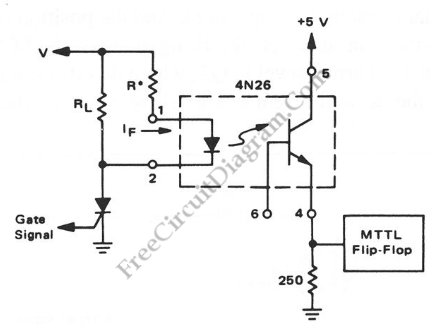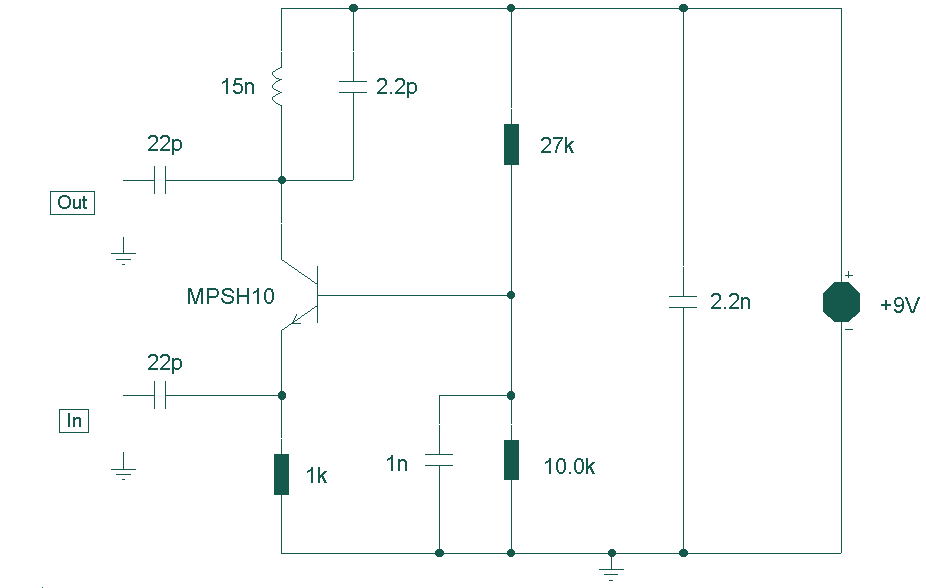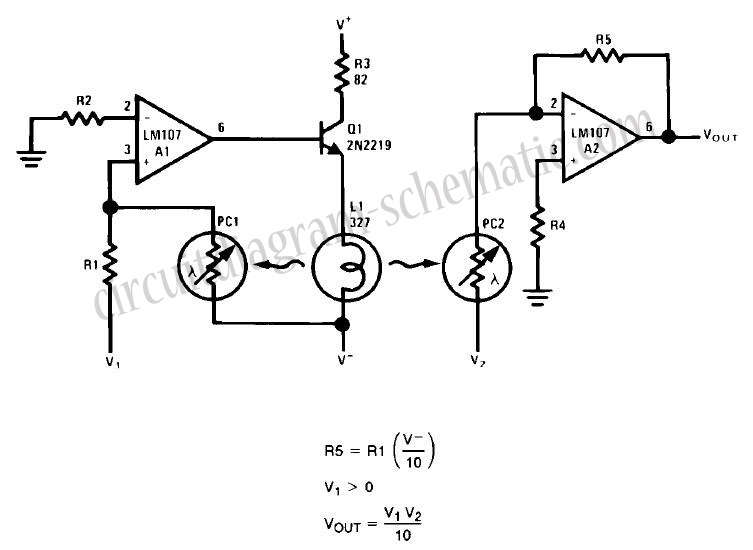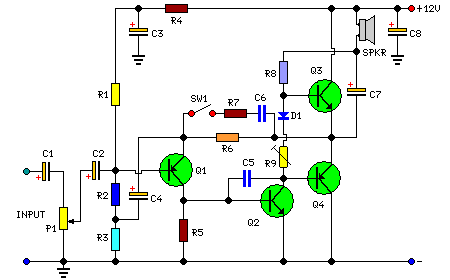
lm2876 40w audio power amplifier circuit design
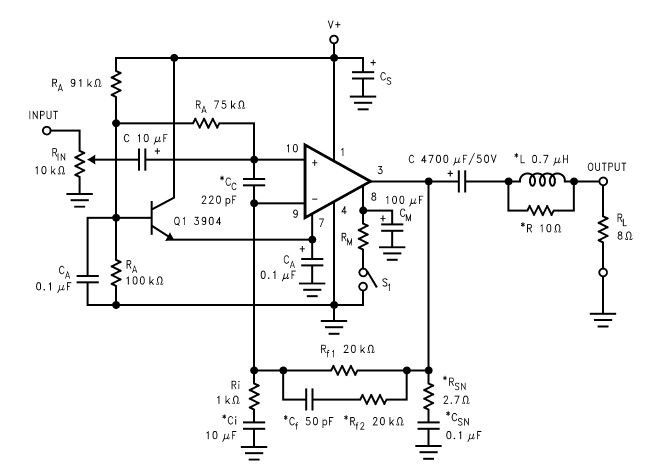
The LM2876 audio power amplifier circuit can be designed as a simple, high-efficiency audio amplifier capable of delivering 40W of continuous average power to an 8-ohm load with a total harmonic distortion plus noise (THD+N) of 0.1% from 20Hz to 20kHz. The LM2876 operates over a wide input voltage range, from 20 to 70 volts, with a typical dual 30-volt power supply (or a single 60-volt supply) functioning effectively. The LM2876 incorporates overvoltage protection circuitry that limits the output current to approximately 4A peak while providing voltage clamping, though this is not achieved through internal clamping diodes. Additionally, the LM2876 features a sophisticated thermal protection scheme to prevent long-term thermal stress on the device. The amplifier shuts down when the die temperature reaches 165 °C and resumes operation when the temperature drops to about 155 °C.
The LM2876 audio power amplifier is designed to deliver high-quality audio output with minimal distortion, making it suitable for various audio applications. The circuit is built around the LM2876 integrated circuit, which is specifically engineered for audio amplification tasks. It is capable of driving an 8-ohm speaker with a continuous output of 40W, ensuring sufficient power for typical audio systems. The low THD+N rating of 0.1% indicates that the amplifier maintains audio fidelity, producing clear sound across the frequency range of 20Hz to 20kHz.
The input voltage range of 20 to 70 volts allows for flexibility in power supply design. A dual power supply configuration using ±30 volts is commonly employed, although a single supply of 60 volts can also be used. This versatility enables the LM2876 to be integrated into various audio setups without the need for complex power supply designs.
The overvoltage protection circuitry is a critical feature of the LM2876, as it safeguards the amplifier from damage due to excessive voltage conditions. By limiting the output current to approximately 4A peak, the LM2876 ensures that it operates within safe parameters, enhancing reliability and longevity. The absence of internal clamping diodes for voltage clamping suggests that the design relies on external components for additional protection, which may be tailored based on specific application requirements.
Thermal management is another vital aspect of the LM2876 design. The built-in thermal protection mechanism is activated when the die temperature reaches 165 °C, effectively shutting down the amplifier to prevent damage from overheating. This automatic shutdown feature is crucial in maintaining the integrity of the device during prolonged use or under heavy load conditions. The amplifier will resume normal operation once the die temperature falls to approximately 155 °C, allowing for continuous use without manual intervention.
In summary, the LM2876 audio power amplifier circuit is a robust solution for high-efficiency audio amplification, offering essential features such as overvoltage protection and thermal management while delivering high-quality audio output. Its design accommodates a wide range of input voltages and provides reliable performance across various audio applications.Using the LM2876 audio power amplifier circuit can be designed a very simple high efficiency power audio amplifier capable of delivering 40W of continuous average power to an 8 © load with 0. 1% THD+N from 20Hz 20kHz. The LM2876 audio power amplifier circuit operates over a wide input voltage range, from 20 up to 70 volts, but typically a dual
30 volt power supply ( or a single 60 volt in this case ) will be work fine. The LM2876 contains overvoltage protection circuitry that limits the output current to approximately 4Apeak while also providing voltage clamping, though not through internal clamping diodes. The LM2876 has a sophisticated thermal protection scheme to prevent long-term thermal stress to the device.
When the temperature on the die reaches 165 °C, the LM2876 shuts down. It starts operating again when the die temperature drops to about 155 °C 🔗 External reference
The LM2876 audio power amplifier is designed to deliver high-quality audio output with minimal distortion, making it suitable for various audio applications. The circuit is built around the LM2876 integrated circuit, which is specifically engineered for audio amplification tasks. It is capable of driving an 8-ohm speaker with a continuous output of 40W, ensuring sufficient power for typical audio systems. The low THD+N rating of 0.1% indicates that the amplifier maintains audio fidelity, producing clear sound across the frequency range of 20Hz to 20kHz.
The input voltage range of 20 to 70 volts allows for flexibility in power supply design. A dual power supply configuration using ±30 volts is commonly employed, although a single supply of 60 volts can also be used. This versatility enables the LM2876 to be integrated into various audio setups without the need for complex power supply designs.
The overvoltage protection circuitry is a critical feature of the LM2876, as it safeguards the amplifier from damage due to excessive voltage conditions. By limiting the output current to approximately 4A peak, the LM2876 ensures that it operates within safe parameters, enhancing reliability and longevity. The absence of internal clamping diodes for voltage clamping suggests that the design relies on external components for additional protection, which may be tailored based on specific application requirements.
Thermal management is another vital aspect of the LM2876 design. The built-in thermal protection mechanism is activated when the die temperature reaches 165 °C, effectively shutting down the amplifier to prevent damage from overheating. This automatic shutdown feature is crucial in maintaining the integrity of the device during prolonged use or under heavy load conditions. The amplifier will resume normal operation once the die temperature falls to approximately 155 °C, allowing for continuous use without manual intervention.
In summary, the LM2876 audio power amplifier circuit is a robust solution for high-efficiency audio amplification, offering essential features such as overvoltage protection and thermal management while delivering high-quality audio output. Its design accommodates a wide range of input voltages and provides reliable performance across various audio applications.Using the LM2876 audio power amplifier circuit can be designed a very simple high efficiency power audio amplifier capable of delivering 40W of continuous average power to an 8 © load with 0. 1% THD+N from 20Hz 20kHz. The LM2876 audio power amplifier circuit operates over a wide input voltage range, from 20 up to 70 volts, but typically a dual
30 volt power supply ( or a single 60 volt in this case ) will be work fine. The LM2876 contains overvoltage protection circuitry that limits the output current to approximately 4Apeak while also providing voltage clamping, though not through internal clamping diodes. The LM2876 has a sophisticated thermal protection scheme to prevent long-term thermal stress to the device.
When the temperature on the die reaches 165 °C, the LM2876 shuts down. It starts operating again when the die temperature drops to about 155 °C 🔗 External reference
